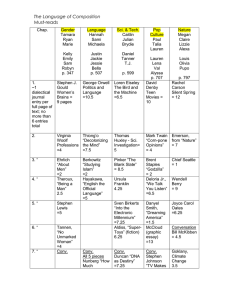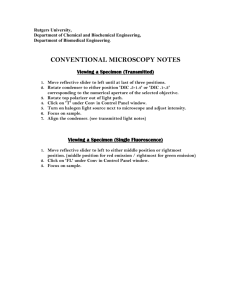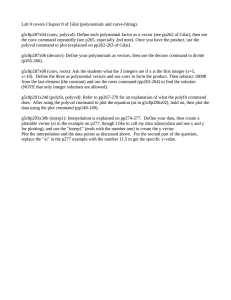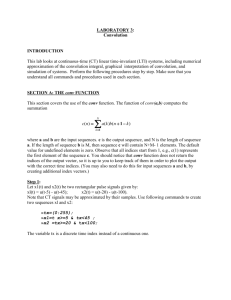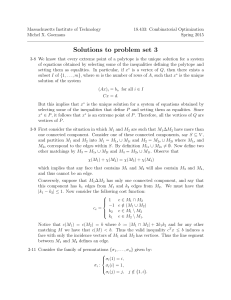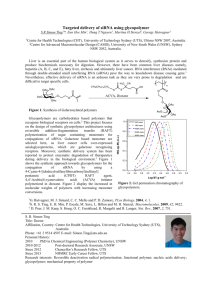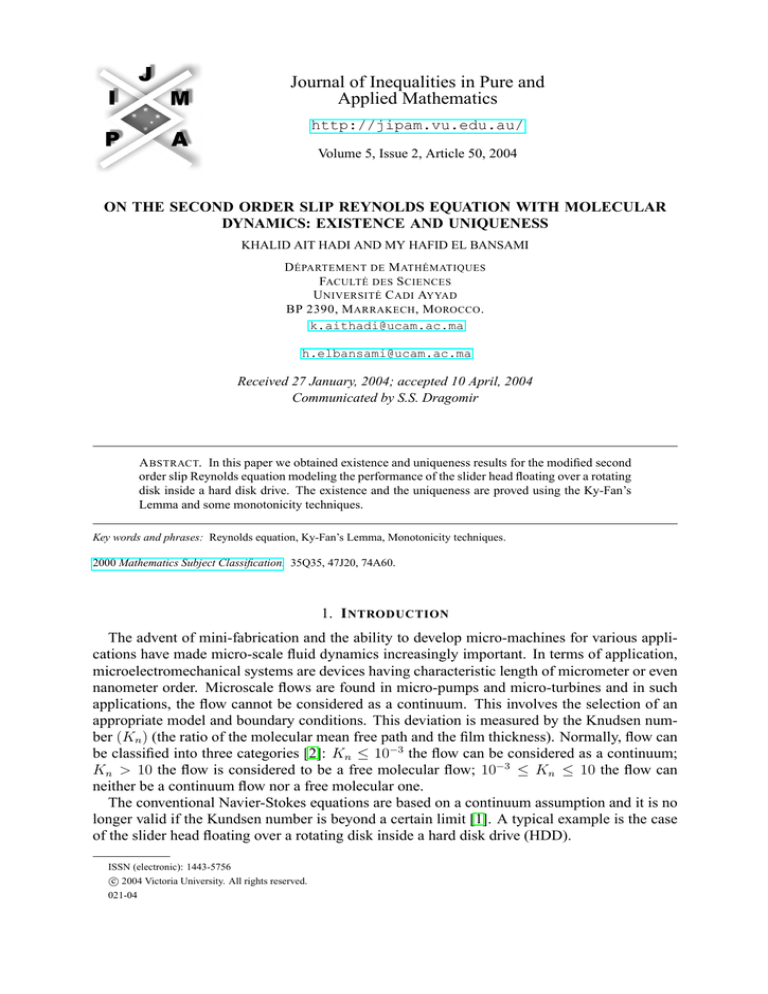
Journal of Inequalities in Pure and
Applied Mathematics
http://jipam.vu.edu.au/
Volume 5, Issue 2, Article 50, 2004
ON THE SECOND ORDER SLIP REYNOLDS EQUATION WITH MOLECULAR
DYNAMICS: EXISTENCE AND UNIQUENESS
KHALID AIT HADI AND MY HAFID EL BANSAMI
D ÉPARTEMENT DE M ATHÉMATIQUES
FACULTÉ DES S CIENCES
U NIVERSITÉ C ADI AYYAD
BP 2390, M ARRAKECH , M OROCCO .
k.aithadi@ucam.ac.ma
h.elbansami@ucam.ac.ma
Received 27 January, 2004; accepted 10 April, 2004
Communicated by S.S. Dragomir
A BSTRACT. In this paper we obtained existence and uniqueness results for the modified second
order slip Reynolds equation modeling the performance of the slider head floating over a rotating
disk inside a hard disk drive. The existence and the uniqueness are proved using the Ky-Fan’s
Lemma and some monotonicity techniques.
Key words and phrases: Reynolds equation, Ky-Fan’s Lemma, Monotonicity techniques.
2000 Mathematics Subject Classification. 35Q35, 47J20, 74A60.
1. I NTRODUCTION
The advent of mini-fabrication and the ability to develop micro-machines for various applications have made micro-scale fluid dynamics increasingly important. In terms of application,
microelectromechanical systems are devices having characteristic length of micrometer or even
nanometer order. Microscale flows are found in micro-pumps and micro-turbines and in such
applications, the flow cannot be considered as a continuum. This involves the selection of an
appropriate model and boundary conditions. This deviation is measured by the Knudsen number (Kn ) (the ratio of the molecular mean free path and the film thickness). Normally, flow can
be classified into three categories [2]: Kn ≤ 10−3 the flow can be considered as a continuum;
Kn > 10 the flow is considered to be a free molecular flow; 10−3 ≤ Kn ≤ 10 the flow can
neither be a continuum flow nor a free molecular one.
The conventional Navier-Stokes equations are based on a continuum assumption and it is no
longer valid if the Kundsen number is beyond a certain limit [1]. A typical example is the case
of the slider head floating over a rotating disk inside a hard disk drive (HDD).
ISSN (electronic): 1443-5756
c 2004 Victoria University. All rights reserved.
021-04
2
K HALID A IT H ADI
AND
M Y H AFID E L BANSAMI
Upper plate is fixed
h1
h
h2
X2
X3
X1
Lower plate is moving at constant velocity Uo
Figure 1.1: Slider-bearing flow geometry
This type of thin-film problem has been approximated by the famous Reynolds equation
which is derived from the inertialess form of the Navier-Stokes equations combined with the
continuity equation. Appropriate modifications such as slip boundary conditions are the realm
of micro-fluid mechanics. Another approach is molecular-based models which are derived from
kinetic theories.
1.1. Reynolds Equation and Molecular Models.
1.1.1. Reynolds equation for thin film problems. The well-known Reynolds equation in the
continuum regime is [7]:
3
3
∂
ρh ∂p
∂
ρh ∂p
∂(ρh) ∂(ρU0 h)
+
=6 2
+
,
∂x1
µ ∂x1
∂x2
µ ∂x2
∂t
∂x1
where h is the local gas bearing thickness, p the local pressure, ρ the local gas density, µ the
viscosity and U0 is the moving plate velocity.
In the slip regime the above equation needs modifications. Taking the Hsia’s second order
model, the boundary conditions are given as follows [9]:
2 − τ ∂Ux1 λ2 ∂ 2 Ux1 Ux1 (x3 = 0) = U0 +
λ
−
+ ···
τ
∂x3 x3 =0
2 ∂x23 x3 =0
2 − τ ∂Ux1 λ2 ∂ 2 Ux1 Ux1 (x3 = h) = −
λ
−
+ ···
τ
∂x3 x3 =h
2 ∂x23 x3 =h
2 − τ ∂Ux2 λ2 ∂ 2 Ux2 Ux2 (x3 = 0) =
λ
−
+ ···
τ
∂x3 x3 =0
2 ∂x23 x3 =0
2 − τ ∂Ux2 λ2 ∂ 2 Ux2 Ux2 (x3 = h) = −
λ
−
+ ···
τ
∂x3 x3 =h
2 ∂x23 x3 =h
Ux1 , Ux2 : the velocity distributions.
τ : is the surface accommodation coefficient.
q
16 µ
λ: is the mean free path, λ = 5 P RT
(where R is a gas constant, T is a local gas temperature
2π
p
and P = pa with pa is the ambient temperature).
For these boundary conditions, the velocity distributions are obtained by solving the momentum
J. Inequal. Pure and Appl. Math., 5(2) Art. 50, 2004
http://jipam.vu.edu.au/
S ECOND O RDER S LIP R EYNOLDS E QUATION
3
equation [9]:
Ux1
Ux2
1
=
2µ
1
=
2µ
∂p
λ + x3
2
2
x − hx3 − hλ − λ + U0 1 −
·
,
∂x1 3
h + 2λ
∂p
·
x23 − hx3 − hλ − λ2 .
∂x2
The second order modified Reynolds equation can hence be obtained by incorporating the
expressions of Ux1 and Ux2 into the continuity equation and then integrating from x3 = 0 to
x3 = h
∂(ρh) 1 ∂(ρU0 h)
+ ·
∂t
2
∂x
1
3
3
∂
1 ∂p
h
∂
1 ∂p
h
2
2
2
2
=
·
ρ
+ λh + λ h +
·
ρ
+ λh + λ h .
∂x1 2µ ∂x1
6
∂x2 2µ ∂x2
6
Normally, the non-dimensional second order slip Reynolds equation (in the stationary regime)
is used which is given by [7]:
3
2
2H
(1.1)
∇ H P + 6Kn H + 6Kn
∇P = Λ · ∇(P H),
P
Λ : is the bearing vector, H =
h
.
h2
1.1.2. The Molecular Models. The mean free path is the average distance travelled by a molecule between collision and is defined as:
mean thermal speed
(1.2)
λ=
.
collision frequency
To obtain the mean free path, it is essential to calculate both the mean thermal speed and collision frequency, the terms in equation (1.2) depend on the molecular models used.
There exists three models: the (HS) Hard sphere model (equation (1.1)), the variable hard
sphere model (VHS) [2] and the (VSS) variable soft sphere [10]. If we take the (HS) model as
0
a reference, we can write a generalized mean free path λ for the three cases (HS, VHS, VSS)
0
where λ = ξλ such that
• ξ = 1 for the (HS) model;
Γ( 9 −$) 1
• ξ = 26 π 2 −$ for the (VHS) model;
αΓ( 92 −$)
1
π 2 −$ for the (VSS) model,
• ξ = (α+1)(α+2)
where α, $, Γ are determined by the type of gas and can be obtained from experimental data.
The non-dimensional modified Reynolds equation may be obtained as:
3
2
2 2H
(1.3)
∇ H P + 6ξKn H + 6ξ Kn
∇P = Λ · ∇(P H).
P
In [4] Chipot and Luskin studied an analogous equation without the 6ξ 2 K 2 H
term, they proved
P
existence and uniqueness by using a change of the unknown function which leads to a new
problem in which the nonlinearity appears in the convection term.
The same proof technique does not work in our case due to the degenerate term 6ξ 2 K 2 H
,
P
which motivated our intention to search in this sense.
In this work we will prove existence and uniqueness of weak solutions of equation (1.3) using
a generalization of the Ky-Fan Lemma and preserving the idea of a new unknown function.
J. Inequal. Pure and Appl. Math., 5(2) Art. 50, 2004
http://jipam.vu.edu.au/
4
K HALID A IT H ADI
2. E XISTENCE
AND
AND
M Y H AFID E L BANSAMI
U NIQUENESS OF S OLUTIONS
2.1. Existence. We consider the following problem (P):
( 3
∇ H P + 6ξKn H 2 + 6ξ 2 Kn2 H
∇P = Λ.∇(P H), x = (x1 , x2 ) ∈ Ω
P
(P)
P = Ψ in ∂Ω,
where Ω is a region of R2 with a smooth boundary ∂Ω.
We assume that the functions H : Ω → R and Ψ : ∂Ω → R satisfy the following hypothesis:
H ∈ W 1,∞ (Ω)
H is bounded in W 1,∞ (Ω) and a ≤ H(x) ≤ b a.e in Ω
(A1 )
with a, b are two positives constants
(A2 )
e defined on Ω
Ψ is the restriction to ∂Ω of a smooth function Ψ
e L2 (Ω) ≤ M
such that k∇Ψk
with M is a positive constant.
We introduce the following set in order to give a variational formulation of (P):
V := u ∈ H 1 (Ω) ∩ L∞ (Ω) / ∃α > 0 such that u(x) ≥ α a.e in Ω .
For the following, we denote by k · k the norm in L2 (Ω).
e ∈ H 1 (Ω), P ∈ V and
Definition 2.1. We say that P is a weak solution of (P) if P − Ψ
0
Z Z
H
(2.1)
H 3 P + 6ξKn H 2 + 6ξ 2 Kn2
∇P · ∇v dx =
P HΛ · ∇v dx ∀v ∈ H01 (Ω).
P
Ω
Ω
We prove the existence of a weak solution of (P) by using a change of the unknown function.
Let us write for P > 0,
3
2
2 2H
(2.2)
H P + 6ξKn H + 6ξ Kn
∇P
P
2
P
P
3
2 2 log(P )
=H ∇
+ 6ξKn + 6ξ Kn
2
H
H2
+ 6ξKn P H∇H + 12ξ 2 Kn2 log(P )∇H.
The new unknown function will be
P2
P
log(P )
+ 6ξKn + 6ξ 2 Kn2
.
(2.3)
u=
2
H
H2
We consider the function g : ]0, +∞[ → R
t2
+ 6ξKn t + 6ξ 2 Kn2 log(t).
2
It is easy to see that g is an increasing and bijective function. We have from the above equality
1
(2.4)
P = κ(x, u),
H
with
(2.5)
κ(x, u) = g −1 H 2 u + 6ξ 2 Kn2 log H .
g(t) =
J. Inequal. Pure and Appl. Math., 5(2) Art. 50, 2004
http://jipam.vu.edu.au/
S ECOND O RDER S LIP R EYNOLDS E QUATION
5
Our initial problem (P) becomes in u
∇ · (H 3 u) = ∇ · [(Λ − 6ξKn ∇H) κ(x, u) − 12ξ 2 Kn2 log κ(x, u)∇H]
+∇ · [12ξKn log H∇H] in Ω
(Pu )
2
u = Ψu = Ψ + 6ξKn Ψ + 6ξ 2 K 2 log(Ψ) in ∂Ω.
n
2
H
H2
We set
e2
e
e
e u = Ψ + 6ξKn Ψ + 6ξ 2 K 2 log(Ψ) ,
Ψ
n
2
H
H2
e u k ≤ M1 (with M1 is a positive constant).
while keeping (due to (A2 )) the fact that k∇Ψ
e u ∈ H01 (Ω) and
Definition 2.2. We say that u is a weak solution of (Pu ) if u − Ψ
Z
Z
3
(2.6)
H ∇u.∇v dx =
(Λ − 6ξKn ∇H) κ(x, u)∇v dx
Ω
Ω
Z
− 12ξ 2 Kn2 log κ(x, u)∇H∇v dx
Ω
Z
+ 12ξKn log H∇H∇v dx ∀v ∈ H01 (Ω).
Ω
The equivalence between (P) and (Pu ) is given by the following result.
Lemma 2.1. u is a weak solution of (Pu ) if and only if P, given by (2.4), is a weak solution of
(P).
Proof. It is clear from (2.2) that the two variational formulas are equivalent. And from (2.3) it
is obvious that if P ∈ V then u ∈ H 1 (Ω). It remains to show that if u is a solution of (Pu ) then
P ∈ V . From (2.4) we have that P ∈ H 1 (Ω) since (g −1 )0 is bounded. On the other hand, we
have classically u ∈ L∞ (Ω). From (2.4) we deduce that P belongs to L∞ (Ω) with P bounded
away from 0, and the proof is ended.
Proposition 2.2. Under hypotheses (A1 ) and (A2 ), if we have
a3
(2.7)
Cp b2
kΛke
6ξKn
>1
+ 3 k∇Hk
(where Cp is the constant of Poincaré [3], kΛke is the Euclidean norm of Λ), then, for all
solution z1 of the following inequality
Z
e u · ∇z1 dx
H 3 ∇ z1 + Ψ
Ω
Z
e u )∇z1 dx
≤
(Λ − 6ξKn ∇H) κ(x, z1 + Ψ
Ω
Z
Z
2 2
e
− 12ξ Kn log κ(x, z1 + Ψu )∇H∇z1 dx + 12ξKn log H∇H∇z1 dx,
Ω
Ω
we have
(2.8)
J. Inequal. Pure and Appl. Math., 5(2) Art. 50, 2004
k∇z1 k ≤ C.
http://jipam.vu.edu.au/
6
K HALID A IT H ADI
AND
M Y H AFID E L BANSAMI
Proof. We have
Z
e u · ∇z1 dx
H 3 ∇ z1 + Ψ
Ω
Z
e u )∇z1 dx
≤
(Λ − 6ξKn ∇H) κ(x, z1 + Ψ
Ω
Z
Z
2 2
e
− 12ξ Kn log κ(x, z1 + Ψu )∇H∇z1 dx + 12ξKn log H∇H∇z1 dx,
Ω
then
Z
3
Ω
Z
2
H (∇z1 ) ≤
Ω
e u )∇z1
(Λ − 6ξKn ∇H) κ(x, z1 + Ψ
Ω
Z
e u )∇H∇z1
− 12ξ 2 Kn2 log κ(x, z1 + Ψ
Ω
Z
Z
e u.
+ 12ξKn log H∇H∇z1 − H 3 ∇z1 ∇Ψ
Ω
Ω
Due to the fact that, for all s ∈ R,
dg −1
g −1 (s)
1
(2.9)
(s) = −1 2
≤
,
0≤
−1
2
2
ds
(g ) (s) + 6ξKn g (s) + 6ξ Kn
6ξKn
d
1
1
≤ 2 2,
0≤
log(g −1 (s)) = −1 2
−1
2
2
ds
(g ) (s) + 6ξKn g (s) + 6ξ Kn
6ξ Kn
it follows that
a3 k∇z1 k2
i
1 h
2
1/2
e u + 6ξ 2 Kn2 log H − 1
≤ k(Λ − 6ξKn ∇H)k∞
H z1 + Ψ
+ |Ω| g −1 (1) k∇z1 k
6ξK
h n
i
2
1/2
e u + 6ξ 2 Kn2 log H − 1
+ 2 k∇Hk∞ H z1 + Ψ
+ |Ω| log g −1 (1) k∇z1 k
3 e + 12ξKn klog H∇Hk k∇z1 k + b ∇Ψu k∇z1 k ,
i.e.
1
2
2
Cp b − 2 k∇Hk∞ Cp b k∇z1 k
a − k(Λ − 6ξKn ∇H)k∞
6ξKn
i
1 h
2e
1/2
2 2
≤ k(Λ − 6ξKn ∇H)k∞
H Ψu + 6ξ Kn log H − 1 + |Ω| g −1 (1)
6ξKn
h
i
2e
+ 2 k∇Hk∞ H Ψu + 6ξ 2 Kn2 log H − 1 + |Ω|1/2 log g −1 (1)
3 e + 12ξKn klog H∇Hk + b ∇Ψu ,
3
where |Ω| is the measure of Ω.
However, if
a3
Cp b2
hence
3
kΛke
6ξKn
a − k(Λ − 6ξKn ∇H)k∞
J. Inequal. Pure and Appl. Math., 5(2) Art. 50, 2004
+ 3 k∇Hk∞
> 1,
1
Cp b2 − 2 k∇Hk∞ Cp b2
6ξKn
> 0,
http://jipam.vu.edu.au/
S ECOND O RDER S LIP R EYNOLDS E QUATION
7
then k∇z1 k ≤ C, where
C=
cte
a3 − k(Λ − 6ξKn ∇H)k∞
1
C b2
6ξKn p
− 2 k∇Hk∞ Cp b2
such that
i
1 h
2e
1/2 −1
2 2
cte = k(Λ − 6ξKn ∇H)k∞
H Ψu + 6ξ Kn log H − 1 + |Ω| g (1)
6ξKn
h
i
e
1/2
2 2
+ 2 k∇Hk∞ H 2 Ψ
log g −1 (1)
u + 6ξ Kn log H − 1 + |Ω|
e + 12ξKn klog H∇Hk + b3 ∇Ψ
u .
Now, we will prove the existence of a weak solution for the problem (Pu ).
Proposition 2.3. If the hypotheses (A1 ), (A2 ) and (2.7) are verified then there exists at least one
weak solution for (Pu ).
For the proof we need the following theorem:
Notation 2.1. We denote by F(X) the family of all non-empty finite subsets of X and by
F(X, x0 ) all elements of F(X) containing x0 . We shall denote by conv(A) the convex hull of
X
A, by A the closure of A in X and by intX (A) the interior of A in X.
Theorem 2.4. Let E be a topological vector space and X be a non-empty convex subset of E;
Φ1 , Φ2 : X × X → R such that:
(1) Φ1 (χ, q) ≤ Φ2 (χ, q) for all χ, q ∈ X and Φ2 (χ, χ) ≤ 0 for all χ ∈ X.
(2) For all A ∈ F(X) and all χ ∈ conv(A), q 7→ Φ1 (χ, q) is lower semicontinuous on
conv(A).
(3) For all q ∈ X, the set {χ ∈ X, Φ2 (χ, q) > 0} is convex.
(4) For all A ∈ F(X) and all χ, q ∈ conv(A) and for every net {qα } converging in X to q
with Φ1 (tχ + (1 − t)q, qα ) ≤ 0 for all α and all t ∈ [0, 1] , we have Φ1 (χ, q) ≤ 0.
(5) There exists a non-empty closed and compact K of X and x0 ∈ K such that Φ1 (x0 , q) >
0 ∀q ∈ X\K.
Then there exists q ∈ K such that Φ1 (χ, q) ≤ 0 ∀χ ∈ X.
Remark 2.5. If the application q 7→ Φ1 (χ, q) is lower semicontinuous on X for all χ ∈ X, then
the conditions (2) and (4) are verified.
Definition 2.3. [6]. T : X → 2E is said to be a KKM -application if for all A ∈ F(X),
conv(A) ⊆ ∪ T (χ).
χ∈A
First, we recall the following lemma that is a generalization of the Ky-Fan’s lemma.
Lemma 2.6. [5]. Let X a non-empty convex subset ⊆ E (a topological vector space) and
T : X → 2E is a KKM-application, we suppose that there exists x0 ∈ X such that:
X
i) T (x0 ) ∩ X is compact on X.
ii) ∀A ∈ F(X, x0 ), ∀χ ∈ conv(A), T (χ) ∩ conv(A) is closed
in conv(A).
iii) ∀A ∈ F(X, x0 ), X ∩ (
∩
χ∈conv(A)
X
T (χ)) ∩ conv(A) =
∩
T (χ) ∩ conv(A).
χ∈conv(A)
Then ∩ T (χ) 6= ∅.
χ∈X
J. Inequal. Pure and Appl. Math., 5(2) Art. 50, 2004
http://jipam.vu.edu.au/
8
K HALID A IT H ADI
AND
M Y H AFID E L BANSAMI
Proof of Theorem 2.4. We put for all χ ∈ X
T (χ) = {q ∈ X / Φ1 (χ, q) ≤ 0} .
X
The condition (5) implies that T (x0 ) ⊆ K , i.e. T (x0 ) is compact on X.
The condition (2) implies that ∀χ ∈ conv(A), T (χ) ∩ conv(A) is closed on conv(A).
Conditions (1) and (3) imply that T is a KKM −application.
Indeed, let us suppose the opposite (T is not a KKM −application), then there exists A ∈ F(X)
and there exists q0 ∈ conv(A) such that q0 ∈
/ ∪ T (χ), i.e. ∀χ ∈ A, Φ1 (χ, q0 ) > 0. However
χ∈A
{χ ∈ X / Φ1 (χ, q0 ) > 0} is convex, then conv(A) ⊂ {χ ∈ X / Φ1 (χ, q0 ) > 0}. Therefore
Φ1 (q0 , q0 ) > 0 by following Φ2 (q0 , q0 ) > 0 (which is absurd).
It remains to show that
X
X ∩ ( ∩ T (χ)) ∩ conv(A) =
∩ T (χ) ∩ conv(A), for all A ∈ F(X).
χ∈conv(A)
Let q ∈ X ∩ (
χ∈conv(A)
∩
χ∈conv(A)
and qα ∈ X ∩ (
X
T (χ)) ∩ conv(A), then there exists a sequence (qα ) such that qα → q
∩
χ∈conv(A)
T (χ)). However qα ∈
∩
χ∈conv(A)
T (χ) implies that Φ1 (χ, qα ) ≤ 0 for all
χ ∈ conv(A), i.e. Φ1 (tχ + (1 − t)q, qα ) ≤ 0, for all χ, q ∈ conv(A)
and for all t ∈ [0, 1]
then (4) implies that Φ1 (χ, q) ≤ 0 for all χ ∈ conv(A) i.e. q ∈
∩ T (χ) ∩ conv(A).
χ∈conv(A)
By application of Lemma 2.6, there exists q ∈ K such that q ∈ T (χ) ∀χ ∈ X, i.e. there exists
q ∈ K such that Φ1 (χ, q) ≤ 0 ∀χ ∈ X.
Proof of Proposition 2.3. We make a translation for the unknown function to bring it to the
e u ∈ H 1 (Ω), then we search w ∈ H 1 (Ω) such that
same space that functions test. Let w = u − Ψ
0
0
Z
Z
(2.10)
H 3 ∇w · ∇vdx =
(Λ − 6ξKn ∇H) κ1 (x, w)∇vdx
Ω
Ω
Z
Z
2 2
− 12ξ Kn log κ1 (x, w)∇H∇vdx + 12ξKn log H∇H∇vdx
Ω
Ω
Z
e u · ∇v dx ∀v ∈ H 1 (Ω),
− H 3 ∇Ψ
0
Ω
e u ).
with κ1 (x, w) = κ(x, w + Ψ
Let us consider the space E := H01 (Ω) endowed with its weak topology and
n
o
X := ϕ ∈ E / kϕkH 1 (Ω) ≤ C + 1
0
(C is the constant given in Proposition 2.2). Consider the following applications:
Z
Z
3
Φ1 (χ, q) := Φ2 (χ, q) :=
H ∇q∇(q − χ)dx − F (q)∇(q − χ)dx
Ω
Ω
such that
F (q) := (Λ − 6ξKn ∇H) κ1 (x, q) − 12ξ 2 Kn2 log κ1 (x, q)∇H
eu
+ 12ξKn log H∇H − H 3 ∇Ψ
for all χ, q in H01 (Ω).
We will show that conditions of the theorem 2.4 are satisfied.
J. Inequal. Pure and Appl. Math., 5(2) Art. 50, 2004
http://jipam.vu.edu.au/
S ECOND O RDER S LIP R EYNOLDS E QUATION
9
Condition (1) is evidently satisfied. Since the application χ → Φ1 (χ, q) is linear then condition (3) is also verified. For condition (5) it is sufficient to take
n
o
K := X = ϕ ∈ E / kϕkH 1 (Ω) ≤ C + 1 .
0
According to Remark 2.5, it is sufficient to demonstrate that the application q 7→ Φ1 (χ, q)
is weakly lower semicontinuous in H01 (Ω) to conclude that conditions (2) and (4) are satisfied.
Indeed, let qn * q in H01 (Ω), then there exists a subsequence qnk such that qnk → q in L2 (Ω) and
∇qnk * ∇q in L2 (Ω). Therefore while using the Lebesgue dominated convergence theorem
and estimations (2.9), we have
Z
Z
Z
a2 F (qnk )∇qnk − χ =
a2 F (qnk )∇qnk − a2 F (qnk )∇χ
Ω
Ω
Z
Z Ω
→
a2 F (q)∇q − a2 F (q)∇χ.
Ω
Ω
For the other term of Φ1 (χ, qnk ) we have
Z
Z
Z
3
3
H .∇qnk ∇(qnk − χ) =
H · ∇qnk ∇qnk − H 3 · ∇qnk ∇χ.
Ω
Ω
2
R
3
Ω
R
However R∇qnk * ∇q in L (Ω), then Ω H · ∇qnk ∇χ → Ω H 3 · ∇q∇χ. It remains to show
that q 7→ Ω H 3 · (∇qnk )2 is weakly lower semicontinuous
in H01 (Ω).
R
We consider the application T : L2 (Ω) → R, z 7→ Ω H 3 · z 2 which is convex and strongly
semi continuous in L2 (Ω) therefore weakly semi continuous in L2 (Ω). However ∇qnk * ∇q
in L2 (Ω) then lim (H 3 · ((∇qnk )2 − (∇q)2 )) ≥ 0, from where we obtain the result.
By application of Theorem 2.4, there exists w ∈ K such that Φ1 (χ, w) ≤ 0 for all χ ∈ X,
however w ∈ intE (X) (according to Proposition 2.2), then Φ1 (χ, w) ≤ 0. In particular, for
χ = w + σ · ξ ∈ X, for all ξ ∈ D(Ω) and σ appropriately chosen, we deduct that Φ1 (ξ, w) = 0,
for all ξ ∈ H01 (Ω) (by density of D(Ω) in H01 (Ω)) which implies that there exists w ∈ H01 (Ω)
satisfying the equation (2.10).
It follows that we have solutions for the problems (Pu ) and (P).
2.2. Uniqueness. In the next lemma we give a general monotonicity and uniqueness result for
a class of semi-linear elliptic problems.
Lemma 2.7. Let I ⊆ R and l : Ω × I → Rn an uniform Lipschitz function in the following
sense:
(2.11)
∃N > 0, |l(x, u1 ) − l(x, u2 )| ≤ N |u1 − u2 | , ∀x ∈ Ω and u1 , u2 ∈ R.
Let j : Ω → R be a function satisfying j(x) ≥ α0 > 0 a.e. x ∈ Ω. Suppose that ui , i = 1, 2, is
a weak solution to
−∇ · (j(x)∇ui ) = ∇ · l(x, ui ), x ∈ Ω
(2.12)
u = ϕ , x ∈ ∂Ω.
i
i
If ϕ1 ≥ ϕ2 a.e. on ∂Ω, then u1 ≥ u2 a.e. on Ω.
Proof. We take u3 = u1 − u2 which satisfies the problem
u3 ∈ ϕ1 − ϕ2 + H01 (Ω)
(2.13)
R j(x)∇u · ∇vdx = R (l(x, u ) − l(x, u )) · ∇vdx.
1
2
Ω
Ω
J. Inequal. Pure and Appl. Math., 5(2) Art. 50, 2004
http://jipam.vu.edu.au/
10
K HALID A IT H ADI AND M Y H AFID E L BANSAMI
u+
1
3
We have that u+
3 ∈ H0 (Ω), so we can take (as in [8]) v = u+ +δ as a test function in (2.13) with
3
δ > 0, which gives
+ + Z
Z
u3
u3
+
(2.14)
j(x)∇u3 · ∇
dx =
(l(x, u1 ) − l(x, u2 )) · ∇
dx.
+
+
u3 + δ
u3 + δ
Ω
Ω
However
∇
u+
3
u+
+
δ
3
∇u+
3
=δ
u+
3 +δ
u+
∇ log 1 + 3
δ
2 ,
=
∇u+
3
,
u+
+
δ
3
which implies
+ Z
Z
+ 2
u3
u
+
(2.15)
j(x)∇u3 · ∇
dx = δ j(x) ∇ log 1 + 3 dx.
+
δ
u3 + δ
Ω
Ω
The right-hand side of (2.14) can be estimated as
Z
+ u3
(2.16)
(l(x, u1 ) − l(x, u2 )) · ∇ u+ + δ dx
Ω
3
+ n Z
X
∂
u3
dx
≤
|li (x, u1 ) − li (x, u2 )| +
∂x
u
+
δ
i
3
i=1 Ω
+ n Z
X
∂
u3
dx
≤N
|u3 | +
∂x
u
+
δ
i
Ω
3
i=1
+ n Z X
+ ∂
u3
u3
=N
+
∂xi u + δ dx.
Ω
3
i=1
However
(2.17)
+
+ ∂u+
+
+ ∂
∂u3
u
u
1
3
3
u3
= δ 3
≤
δ
+
2
∂xi u+ + δ +
∂x
∂x
u
+
δ
i u3 + δ
i
3
3
+ + ∂
u
u
3
≤ δ ∇ log 1 + 3 .
= δ log 1 +
∂xi
δ δ So, from (2.14) we obtain using also (2.15) – (2.17),
Z Z + 2
+ u
u
3
dx ≤ N · n ∇ log 1 + 3 dx.
(2.18)
α0 ∇ log 1 +
δ δ Ω
Ω
u+
Since log 1 + δ3 ∈ H01 (Ω), from the Poincaré inequality we deduce
Z + 2
u
log 1 + 3 dx ≤ C2 ,
(2.19)
δ Ω
where C2 is independent on δ.
Then we have u+
3 = 0 a.e. x ∈ Ω and the proof is ended.
Proposition 2.8. Under the hypotheses (A1 ) and (A2 ), we have uniqueness among all weak
solutions of problem (P).
Lemma 2.9. We suppose that ui is a weak solution to (Pu ) corresponding to the boundary data
Ψiu , i = 1, 2. If Ψ1u ≥ Ψ2u a.e. on ∂Ω, then u1 ≥ u2 a.e. on Ω. Further, we have uniqueness
among all weak solutions of problem (Pu ).
J. Inequal. Pure and Appl. Math., 5(2) Art. 50, 2004
http://jipam.vu.edu.au/
S ECOND O RDER S LIP R EYNOLDS E QUATION
11
Proof. We apply Lemma 2.7 with j = H 3 and
l = (Λ − 6ξKn ∇H) κ(x, u) − 12ξ 2 Kn2 log κ(x, u)∇H + 12ξKn log H∇H.
Due to the fact that, for all s ∈ R,
dg −1
g −1 (s)
1
0≤
(s) = −1 2
≤
,
−1
2
2
ds
(g ) (s) + 6ξKn g (s) + 6ξ Kn
6ξKn
d
1
1
0≤
log(g −1 (s)) = −1 2
≤
ds
(g ) (s) + 6ξKn g −1 (s) + 6ξ 2 Kn2
6ξ 2 Kn2
1,∞
and the fact that H ∈ W (Ω), the Lipschitz condition (2.11) is satisfied for l.
Proof of Proposition 2.8. The proof is a consequence of Lemmas 2.1 and 2.9 and the fact that
g −1 is an increasing function.
R EFERENCES
[1] A. BESKOK, Simulations an models for gas flows in microgeometries, Ph.D. Dissertation Princeton University, 1996.
[2] G.A. BIRD, Molecular Gas Dynamics and the Direct Simulation of Gas Flows, Oxford, Clarendon,
1994.
[3] H. BREZIS, Analyse fonctionnelle Théorie et Applications, Masson, Paris, 1983.
[4] M. CHIPOT AND M. LUSKIN, Existence and uniqueness of solutions to the compressible
Reynolds lubrication equation, SIAM. J. Math. Anal., 17 (1986), 1390–1399.
[5] M.S.R. CHOWDHURY AND K.K. TAN, Generalization of Ky Fan’s minmax inequality with applications to generalized variational inequalities for pseudo-monotone operators and fixed points
theorems, J. Math. Anal. Appl., 204 (1996), 910–929.
[6] A. EL ARNI, Generalized Quasi-variational inequalities on non-compact sets with pseudomonotone operators, J. Math. Anal. Appl, 249 (2000), 515–526.
[7] S. FUKUI AND R. KANEKO, Analysis of ultra-thin gas film lubrication based on linearized Boltzmann equation: first report-derivation of a generalized lubrication equation including thermal creep
flow, ASME J. Tribol., 110 (1988), 253–262.
[8] D. GILBARG AND N.S. TRUDINGER, Elliptic Partial Differential Equations of Second Order,
2nd ed., Springer-Verlag, Berlin, 1983.
[9] Y.T. HSIA AND G.A. DOMOTO, An experimental investigation of molecular rarefaction effects in
gas lubricated bearings at ultra-low clearances, ASME J. Tribol., 105 (1983), 120–130.
[10] K. KOURA AND H. MATSUMOTO, Variable soft sphere molecular model for inverse power law
or Lennard-Jones potential, Phys. Fluids A, 4 (1992), 1083–1085.
J. Inequal. Pure and Appl. Math., 5(2) Art. 50, 2004
http://jipam.vu.edu.au/

